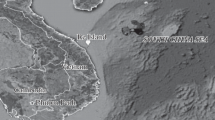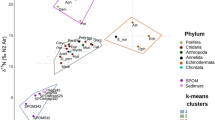Abstract
In summer 1998, shallow water corals at Sesoko Island, Japan (26°38′N, 127°52′E) were damaged by bleaching. In August 2003, partially damaged colonies of the massive Porites lutea and the branching P. cylindrica were collected at depths of 1.0–2.5 m. The species composition of epilithic algal communities on dead skeletal surfaces of the colonies (‘red turfs’, ‘green turfs’, ‘red crusts’) and the endolithic algae (living in coral skeletons) growing close to and away from living coral polyps was determined. Carbon and nitrogen stable isotope values of organic matter (δ13C and δ15N) from all six of these biological entities were determined. There were no significant differences in the isotope composition of coral tissues of the two corals, with P. lutea having δ13C of −15.3 to −9.6‰ and δ15N of 4.7–6.1‰ and P. cylindrica having similar values. Polyps in both species living close to an interface with epilithic algae had similar isotope values to polyps distant from such an interface. Despite differences in the relative abundance of the algal species in red turfs and crusts, their δ13C and δ15N values were not significantly different from each other (−18.2 to −13.9, −20.6 to −16.2, 1.1–4.3, and 3.3 to 4.9‰, respectively). The green algal turf had significantly higher δ13C values (−14.9 to −9.3‰) than that of red turfs and crusts but similar δ15N (1.2–4.1‰) to the red algae. The data do not suggest that adjoining associations of epilithic algae and coral polyps exchange carbon- and nitrogen-containing metabolites to a significant extent. The endolithic algae in the coral skeletons had δ13C values of −14.8 to −12.3‰ and δ15N of 4.0–5.4‰. Thus they did not differ significantly from the coral polyps in their carbon and nitrogen isotope values. The similarity in carbon isotope values between the coral polyps and endolithic algae may be attributed to a common source of CO2 for zooxanthellae and endolithic algae, namely, from respiration by the coral host. While it is difficult to fully interpret similarity in the nitrogen isotope composition of coral tissue and of green endolithic algae and the difference in δ15N between green epilithic and endolithic algae, the data are consistent with nitrogen-containing metabolites from the scleractinian coral serving as a significant source of nitrogen for the endolithic algae.


Similar content being viewed by others
References
Allemand D, Ferrier-Pages C, Furla P, Houlbreque F, Puverel S, Reynaud S et al (2004) Biomineralisation in reef-building corals: from molecular mechanisms to environmental control. Comptes Rendus Palevol Acad Sci Paris 3:453–467
Deuser WG, Hunt JM (1969) Stable isotope ratios of dissolved inorganic carbon in the Atlantic. Deep Sea Res 16:221–225
Diaz-Pulido G, McCook LJ (2002) The fate of bleached corals: patterns and dynamics of algal recruitment. Mar Ecol Prog Ser 232:115–128. doi:10.3354/meps232115
Fine M, Loya Y (2002) Endolithic algae: an alternative source of photoassimilates during coral bleaching. Proc R Soc Lond B Biol Sci 269:1205–1210. doi:10.1098/rspb.2002.1983
Giordano M, Beardall J, Raven JA (2005) CO2 concentrating mechanisms in algae: mechanisms, environmental modulation and evolution. Annu Rev Plant Biol 56:99–131. doi:10.1146/annurev.arplant.56.032604.144052
Heikoop JM, Dunn JJ, Risk MJ, Sandeman IM, Schwarcz HP, Waltho N (1998) Relationship between light and the δ15N of coral tissue: examples from Jamaica and Zanzibar. Limnol Oceanogr 43:909–920
Heikoop JM, Risk MJ, Lazier AV, Edinger EN, Jompa J, Limmon GV, Dunn JJ, Browne DR, Schwarcz HP (2000) Nitrogen–15 signals of anthropogenic nutrient loading in reef corals. Mar Pollut Bull 40:628–636. doi:10.1016/S0025-326X(00)00006-0
Kevekordes K, Holland D, Häubner N, Jenkins S, Kos R, Roberts S et al (2006) Inorganic carbon acquisition by eight species of Caulerpa (Caulerpaceae, Chlorophyta). Phycologia 45:442–449. doi:10.2216/05-55.1
Le Campion-Alsumard T, Golubic S, Hutchings P (1995) Microbial endoliths in skeletons of live and dead corals: Porites lobata (Moorea, French Polynesia). Mar Ecol Prog Ser 117:149–157. doi:10.3354/meps117149
Minagawa M, Wada E (1984) Stepwise enrichment of 15N along food chains: further evidence and the relation between 15N and animal age. Geochim Cosmochim Acta 48:1135–1140. doi:10.1016/0016-7037(84)90204-7
Muscatine L, D’Elia CF (1978) The uptake, retention, and release of ammonium by reef corals. Limnol Oceanogr 23:725–734
Muscatine L, Kaplan IR (1994) Resource partitioning by reef corals as determined from stable isotope composition II. δ15N of zooxanthellae and animal tissue versus depth. Pac Sci 48:304–312
Muscatine L, Porter JW, Kaplan IR (1989) Resource partitioning by reef corals as determined from stable isotope composition I. δ13C of zooxanthellae and animal tissue versus depth. Mar Biol (Berl) 100:185–193. doi:10.1007/BF00391957
Rau GH, Teyssie JL, Rassoulzadegan F, Fowler SW (1990) 13C/12C and 15N/14N variations among size-fractionated marine particles: implications for their origin and trophic relationships. Mar Ecol Prog Ser 59:33–38. doi:10.3354/meps059033
Raven JA (2003) Inorganic carbon concentrating mechanisms in relation to the biology of algae. Photosynth Res 77:155–171. doi:10.1023/A:1025877902752
Raven JA, Johnston AM, Kübler JE, Korb RE, McInroy SG, Handley LL et al (2002) Mechanistic interpretation of carbon isotope discrimination by marine macroalgae and sea grasses. Funct Plant Biol 29:355–378. doi:10.1071/PP01201
Raven JA, Ball LA, Beardall J, Giordano M, Maberly SC (2005) Algae lacking carbon-concentrating mechanisms. Can J Bot Rev Canadienne Botanique 83:879–890. doi:10.1139/b05-074
Risk MJ, Sammarco PW, Schwarcz HP (1994) Cross-continental shelf trends in δ13C in coral on the Great Barrier Reef. Mar Ecol Prog Ser 106:121–130. doi:10.3354/meps106121
Roberts JM, Davies PS, Fixter LM (1999) Symbiotic anemones can grow when starved: nitrogen budget for Anemonia viridis in ammonium-supplemented seawater. Mar Biol (Berl) 133:29–35. doi:10.1007/s002270050439
Rodrigues AU, Grottoli AG (2006) Calcification rate and the stable carbon, oxygen, and nitrogen isotopes in the skeleton, host tissue, and zooxanthellae bleached and recovering Hawaiian corals. Geochim Cosmochim Acta 70:2781–2789. doi:10.1016/j.gca.2006.02.014
Sammarco PW, Risk MJ, Schwarcz HP, Heikoop JM (1999) Cross-continental shelf trends in δ15N in coral on the Great Barrier Reef: further consideration of the reef nutrient paradox. Mar Ecol Prog Ser 180:131–138. doi:10.3354/meps180131
Schlichter D, Zscharnack B, Krisch H (1995) Transfer of photoassimilates from endolithic algae to coral tissue. Naturwissenschaften 82:561–564. doi:10.1007/BF01140246
Swart PK, Saied A, Lamb K (2005) Temporal and spatial variation in the delta N-15 and delta C-13 of coral tissue and zooxanthellae in Montastrea faveolata collected from the Florida reef tract. Limnol Oceanogr 50:1049–1058
Tanaka Y, Miyajima T, Koike I, Hayashibara T, Ogawa H (2006) Translocation and conservation of organic nitrogen within the coral-zooxanthella symbiotic system of Acropora pulchra, as demonstrated by dual isotope-labeling techniques. J Exp Mar Biol Ecol 336:110–119. doi:10.1016/j.jembe.2006.04.011
Titlyanov EA, Titlyanova TV (2002) Reef-building corals–symbiotic autotrophic organisms: 1. General structure, feeding pattern and light-dependent distribution in the shelf. Russ J Mar Biol 28:1–15. doi:10.1023/A:1021836204655
Titlyanov EA, Novojilov AD, Cherbadgy II (1993) Ahnfeltia tobuchiensis: Biology, ecology, productivity. “Nauka” Moscow, 208 p
Titlyanov EA, Titlyanova TV, Yakovleva IM, Nakano Y, Bhagooli R (2005) Regeneration of artificial injuries on scleractinian corals and coral/algal competition for newly formed substrate. J Exp Mar Biol Ecol 323:27–42. doi:10.1016/j.jembe.2005.02.015
Titlyanov EA, Kiyashko SI, Titlyanova TV, Yakovleva IM, Wada E (2006) Coral-algal competition as determined from the rate of overgrowth, physiological condition of polyps of the scleractinian coral Porites lutea, and structure of algal associations within boundary areas. Proc 10th int coral reef symp, pp 1931–1942
Titlyanov EA, Titlyanova TV, Yakovleva IM, Sergeeva OS (2007) Interaction between benthic algae (Lyngbya bouillonii, Dictyota dichotoma) and scleractinian coral Porites lutea in direct contact. J Exp Mar Biol Ecol 342:282–291
Tribollet A, Landon C, Golubic S, Atkinson M (2006) Endolithic microflora are major primary production in dead carbonate substrates of Hawaiian Coral Reefs. J Phycol 42:290–303. doi:10.1111/j.1529-8817.2006.00198.x
Wang WL, Yeh HW (2003) Delta C-13 values of marine macroalgae from Taiwan. Bot Bull Acad Sin 44:107–112
Williams PM, Gordon LI (1970) Carbon-13: carbon-12 ratios in dissolved and particulate organic matter in the sea. Deep-Sea Res 17:19–27
Yamamuro M, Kyanne H, Minagawa M (1995) Carbon and nitrogen stable isotopes of primary producers in coral reef ecosystems. Limnol Oceanogr 40:617–621
Yellowlees D, Rees TA, Fitt WK (1994) Effect of ammonium-supplemented seawater on glutamine synthetase and glutamate dehydrogenase activities in host tissue and zooxanthellae of Pocillopora damicornis and on ammonium uptake rates of the zooxanthellae. Pac Sci 48:291–295
Acknowledgments
This study was supported by the State Program ‘Comprehensive analyses on biodiversity in coral reef and island ecosystems in Asian and Pacific regions’ (Japan, Leader of the program Prof. Makoto Tsuchiya). We are grateful to all staff at the Sesoko Station (Ryukyu University) for use of facilities, technical help, hospitality, and facilitation of research work. The University of Dundee is a registered Scottish charity, No. SC015096.
Author information
Authors and Affiliations
Corresponding author
Additional information
Communicated by J.P. Grassle.
Appendix
Appendix
Rights and permissions
About this article
Cite this article
Titlyanov, E.A., Kiyashko, S.I., Titlyanova, T.V. et al. δ13C and δ15N values in reef corals Porites lutea and P. cylindrica and in their epilithic and endolithic algae. Mar Biol 155, 353–361 (2008). https://doi.org/10.1007/s00227-008-1025-9
Received:
Accepted:
Published:
Issue Date:
DOI: https://doi.org/10.1007/s00227-008-1025-9




